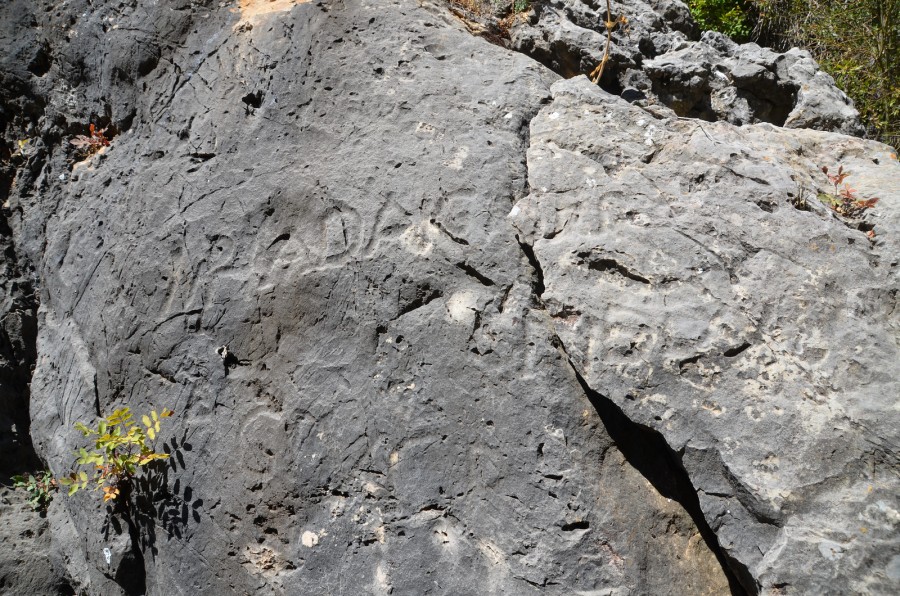Hadrian in Farbe - erstaunlich!
Schlagwort: hadrian

The forest inscriptions of Hadrian in Mount Lebanon
Beautifully documented, scientifically written – I like this blog soo much! My compliments!
Lebanon is famously known for the presence of a very special kind of tree, the legendary cedar tree (cedrus libani). It is emblazoned on the national flag and is, due to its long history, one of the most defining features of Lebanon’s culture. The country is the most densely wooded in the Middle East, and pines, oaks, firs, cypresses and junipers are also found in the mountain areas. All these species of trees were an important source of timber for early civilizations of the Near East and the Nile.
 The cedars of Lebanon.
The cedars of Lebanon.
Wood was one of the most sought-after commodities in antiquity, and references to the cedars go as far back as the beginning of the written script. The episode of the visit of Gilgamesh with his companion Enkidu to a forest to destroy the guardian monster and cut the trees can be traced back to the third millennium…
Ursprünglichen Post anzeigen 1.552 weitere Wörter

Exhibition: ‚Antinous: Boy made God‘ at the Ashmolean Museum in Oxford (UK)
What an impressive collection! Definitely worth a visit – well, after this complete article we already learned a lot.
Antinous has attracted renewed fascination since the High Renaissance. In the early 1500s, several portraits of the ‚boy-favourite‘ were known in Rome, and numerous works of art were modelled on him. A clear example of the appeal of Antinous from this time may be seen in Lorenzetto’s statue of Jonah in the Chuch of Santa Maria del Popolo in Rome. The head of the famous Farnese Antinous seems to have provided the model for the statue of the biblical prophet which was designed by none other than Raphael, one of the most famous artists of his time. The statue became one of the earliest post-classical visual representations of Antinous.
 Jonah-Antinous
Jonah-Antinous
By the 1700s, the beautiful Bithynian had transformed from a scandalous decadent pagan into an archetype of classical male beauty and Romantic ideal. Young aristocrats who, in the eighteen century, made the ‚Grand Tour‘ of Italy to collect…
Ursprünglichen Post anzeigen 2.115 weitere Wörter

Felix dies natalis, Hadriane!
Happy Birthday from me, too!
Carole does a wonderful job documenting the life of this impressive Roman Emperor. Exploring history as its best. Thank you!
Happy 1943rd birthday, Hadrian!
This year, I decided to cook Cato the Elder’s recipe for Libum (sweet cheesecake) as Hadrian’s birthday cake.
 Libum(original recipe from LacusCurtius):
Libum(original recipe from LacusCurtius):
Bray 2 pounds of cheese thoroughly in a mortar; when it is thoroughly macerated, add 1 pound of wheat flour, or, if you wish the cake to be more dainty, ½ pound of fine flour, and mix thoroughly with the cheese. Add 1 egg, and work the whole well. Pat out a loaf, place on leaves, and bake slowly on a warm hearth under a crock.
Modern recipe (serves 2)
- 180-200g plain, all purpose flour
- 225g ricotta cheese
- 1 egg, beaten
- bay leaves
- 1/2 cup clear honey
Sift the flour into a bowl. Beat the cheese until it’s soft and stir it into the flour along with the egg. Form a soft dough and divide into 4. Mold each one into a…
Ursprünglichen Post anzeigen 162 weitere Wörter

January AD 119 – Hadrian inaugurates the new year in Rome (#Hadrian1900)
Instead of a Happy New Year article I am glad to forward this to you.
A peaceful, successful, and meaningful Year 2019 to you all!
 Janus.
Janus.
1,900 years ago, Hadrian celebrated the new year (year 872 Ab urbe condita) in Rome as consul for the third time (COS III) and appointed Publius Dasumius Rusticus as ordinary consul.
Rusticus is known only from his consulship and the reason why he received this prestigious honour is not known. It may be that he was a childhood friend or associate of Hadrian’s. The Dasumii family originated from Hispania Baetica, the home province of Hadrian. Together with the Aelli (Hadrian’s family) and the Ulpii (Trajan’s family), the Damusii were part of the intellectual, economic and political elite of the Empire.
 Inscription from Stobi (Macedonia) mentioning the consulship of Publius Dasumius Rusticus. AD 119.
Inscription from Stobi (Macedonia) mentioning the consulship of Publius Dasumius Rusticus. AD 119.
[P]ro [sal(ute) I]mp(eratoris) Tra[iani Hadriani Aug(usti) Libero statu]/[a]m posuit L(ucius) Dexsius(!) Longinus vet(e)ranus ex praet(orio) / Imp(eratore) Caes(are) Traiano (H)adriano Aug(usto) III P(ublio) Dasumio Rustico co(n)s(ulibus) de s/[uis]
© Epigraphik-Datenbank Clauss / Slaby…
Ursprünglichen Post anzeigen 605 weitere Wörter

